
The Madagascar lowland forests or Madagascar humid forests are a tropical moist broadleaf forest ecoregion found on the eastern coast of the island of Madagascar, home to a plant and animal mix that is 80 to 90% endemic, with the forests of the eastern plain being a particularly important location of this endemism. They are included in the Global 200 list of outstanding ecoregions.
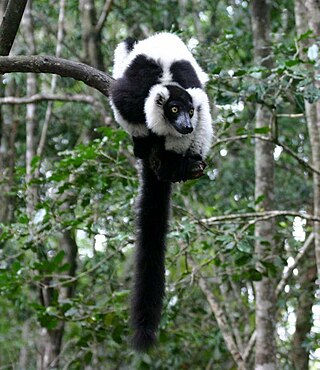
The ruffed lemurs of the genus Varecia are strepsirrhine primates and are the largest extant lemurs within the family Lemuridae. Like all living lemurs, they are found only on the island of Madagascar. Formerly considered to be a monotypic genus, two species are now recognized: the black-and-white ruffed lemur, with its three subspecies, and the red ruffed lemur.
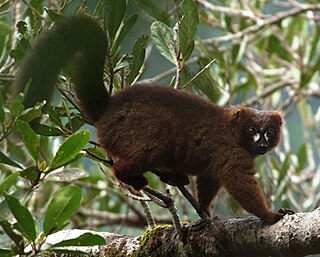
The red-bellied lemur is a medium-sized strepsirrhine primate with a luxuriant chestnut brown coat. This lemur is endemic to eastern Madagascan rainforests and is distinguished by patches of white skin below the eyes, giving rise to a "teardrop" effect, particularly conspicuous in the male.

The red ruffed lemur is one of two species in the genus Varecia, the ruffed lemurs; the other is the black-and-white ruffed lemur. Like all lemurs, it is native to Madagascar. It occurs only in the rainforests of Masoala, in the northeast of the island. It is one of the largest primates of Madagascar with a body length of 53 cm, a tail length of 60 cm and a weight of 3.3–3.6 kg. Its soft, thick fur is red and black in color and sports a buff or cream colored spot at the nape, but a few are known to have a white or pink patch on the back of the limbs or digits and a ring on the base of the tail in a similar color.

The Madagascar dry deciduous forests represent a tropical dry forest ecoregion situated in the western and northern part of Madagascar. The area has high numbers of endemic plant and animal species but has suffered large-scale clearance for agriculture. They are among the world's richest and most distinctive dry forests and included in the Global 200 ecoregions by the World Wide Fund. The area is also home to distinctive limestone karst formations known as tsingy, including the World Heritage Site of Bemaraha.
Nosy Mangabe is a small island reserve located in Antongil Bay about 2 km offshore from the town of Maroantsetra in north-east Madagascar. it is accessible by small boat and is part of the larger Masoala National Park complex. It is a tropical rainforest national park for a species of lemur, the aye-aye. It lies close enough to Maroantsetra for a day trip, although an overnight stay is recommended for seeing the nocturnal aye-aye.
In 2001, the Madagascar Ministry of Environment and Forests, in collaboration with the Wildlife Conservation Society (WCS), launched a program to create the 372,470 ha Makira Forest Protected Area, with first temporary legal protections provided in 2005 as Makira Protected Area. Formally established as Makira Natural Park in 2012, the site is one of the largest of Madagascar’s protected areas and encompasses 372,470 hectares of strictly protected forest buffered by more than 350,000 hectares of community-managed forests. The Makira Natural Park is managed by WCS on behalf of the Government of Madagascar under a delegated management contract.
Andasibe-Mantadia National Park is a 155 square kilometre protected area, located about 150 km east of Antananarivo, consisting principally of primary growth forest in Alaotra-Mangoro Region in eastern Madagascar. The park's elevation ranges from 800 to 1260 meters, with a humid climate. Average annual precipitation is 1700 mm, with rainfall on 210 days of each year. This rainforest is habitat to a vast species biodiversity, including many endemic rare species and endangered species, including 11 lemur species. The park's two component parts are Mantadia National Park and Analamazoatra Reserve, which is best known for its population of Madagascar's largest lemur, the indri.

Lemurophoenix halleuxii is a species of palm tree, the only species in the genus Lemurophoenix. It is found only in Madagascar. It is threatened by habitat loss and overcollection. There are perhaps 300 mature individuals remaining in the wild.

Orania ravaka is a species of flowering plant in the family Arecaceae.
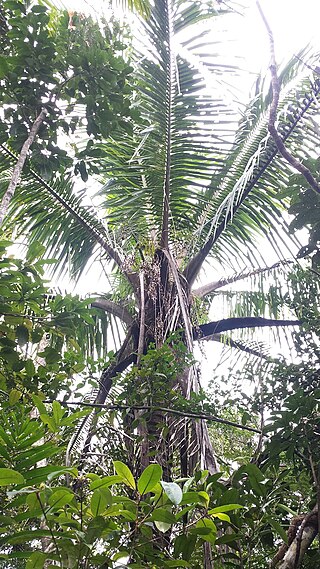
Voanioala gerardii, commonly known as the forest coconut, is a species of flowering plant in the family Arecaceae. It is a relative of the coconut, and is generally regarded as monotypic within the genus Voanioala. However, a team of geneticists headed by Bee F. Gunn found sufficient genetic variation within Voanioala to constitute at least two and possibly four cryptospecies. Voanioala is endemic to Madagascar, and is threatened by habitat loss. Voanioala is harvested for its edible seeds and palm heart. It is estimated that there are fewer than 15 mature trees remaining.

The silky sifaka is a large lemur characterized by long, silky, white fur. It has a very restricted range in northeastern Madagascar, where it is known locally as the simpona. It is one of the rarest mammals on Earth. The silky sifaka is one of nine sifaka species, and one of four former subspecies of diademed sifaka (P. diadema). Studies in 2004 and 2007 compared external proportions, genetics, and craniodental anatomy supporting full species status, which has generally been accepted.
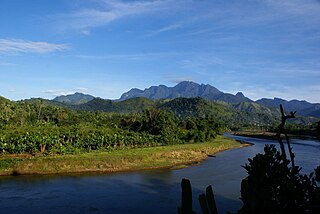
Marojejy National Park is a national park in the Sava region of northeastern Madagascar. It covers 55,500 ha (214 sq mi) and is centered on the Marojejy Massif, a mountain chain that rises to an elevation of 2,132 m (6,995 ft). Access to the area around the massif was restricted to research scientists when the site was set aside as a strict nature reserve in 1952. In 1998, it was opened to the public when it was converted into a national park. It became part of the World Heritage Site known as the Rainforests of the Atsinanana in 2007. "Unique in the world, a place of dense, jungly rainforests, sheer high cliffs, and plants and animals found nowhere else on earth", Marojejy National Park has received plaudits in the New York Times and Smithsonian Magazine for its natural beauty and rich biodiversity that encompasses critically endangered members of the silky sifaka. To that end, a global consortium of conservation organizations, including the Lemur Conservation Foundation, Duke Lemur Center and Madagascar National Parks, have sought to promote research and conservation programs in Marojejy National Park, neighboring Anjanaharibe-Sud Reserve and Antanetiambo Private Reserve, to protect the endemic flora and fauna that reside in northeastern Madagascar. In addition, these organizations have implemented a variety of community-based initiatives to mitigate human encroachment on the park, such as poaching and selective logging, by encouraging local communities to engage in afforestation and silvicultural initiatives to promote a sustainable alternative to mining, slash-and-burn agriculture, and wood collection.

Tsingy de Namoroka National Park, formerly known as Tsingy de Namoroka Strict Nature Reserve, is a national park located in the northwestern part of Madagascar in the Mahajanga Province, specifically, the Soalala District.

Tsimanampetsotsa National Park also spelt Tsimanampetsotse, and known as Tsimanampetsotsa Nature Reserve is a 432 km2 national park on the south-west coast of Madagascar in the region Atsimo-Andrefana. The park is 90 kilometres (56 mi) south of Toliara and 950 kilometres (590 mi) south of the capital, Antananarivo. Route Nationales (RN) 10 to Faux Cap passes the park and the nearest airport is at Toliara. The national park contains and is named after Lake Tsimanampetsotsa.

Zahamena National Park is a national park of Madagascar. Established in 1997, it covers an area of 423 square kilometres (163.32 sq mi) out of a total protected area of 643 square kilometres (248.26 sq mi). It is part of a UNESCO World Heritage Site, Rainforests of the Atsinanana, inscribed in 2007 and consisting of 13 specific areas located within eight national parks in the eastern part of Madagascar. In 2001, Bird Life International assessed avifauna of 112 species of which 67 species are exclusively endemic to Madagascar.
Ambatovaky Special Reserve is a tropical rainforest and wildlife reserve in the north-east of Madagascar. It is designated by Bird Life International as an Important Bird Area for the large number of endemic species of birds.
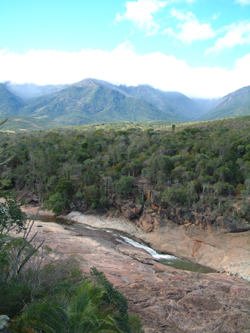
The Rainforests of the Atsinanana is a World Heritage Site that was inscribed in 2007 and consists of 13 specific areas in six national parks in the eastern part of Madagascar:
- Marojejy National Park
- Masoala National Park
- Zahamena National Park
- Ranomafana National Park
- Andringitra National Park
- Andohahela National Park

Illegal logging has been a problem in Madagascar for decades and is perpetuated by extreme poverty and government corruption. Often taking the form of selective logging, the trade has been driven by high international demand for expensive, fine-grained lumber such as rosewood and ebony. Historically, logging and exporting in Madagascar have been regulated by the Malagasy government, although the logging of rare hardwoods was explicitly banned from protected areas in 2000. Since then, government orders and memos have intermittently alternated between permitting and banning exports of precious woods. The most commonly cited reason for permitting exports is to salvage valuable wood from cyclone damage, although this reasoning has come under heavy scrutiny. This oscillating availability of Malagasy rosewood and other precious woods has created a market of rising and falling prices, allowing traders or "timber barons" to stockpile illegally sourced logs during periodic bans and then flood the market when the trade windows open and prices are high. Over 350,000 trees were illegally felled in Madagascar between 2010 and 2015, according to TRAFFIC.
Schizolaena masoalensis is a plant in the family Sarcolaenaceae. It is endemic to Madagascar. The specific epithet refers to the Masoala peninsula where the species is found.



















